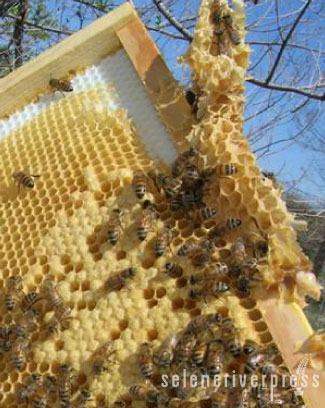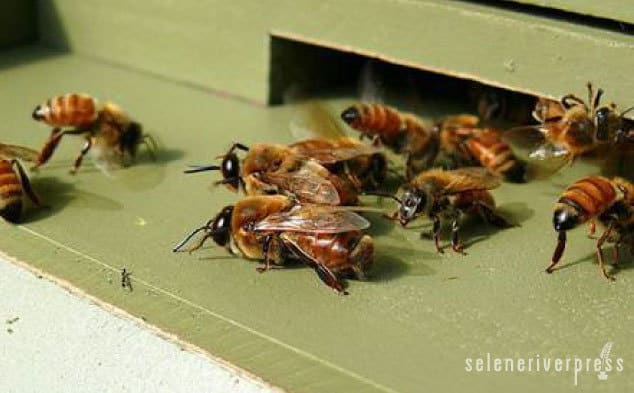Male honeybees are called drones. Let me just drone on about them for a while.
Drones are insects, not to be confused with the high-tech gadgets used to spy on you in modern times.
Honeybee drones are good for only one thing: passing their mother’s genes on to future generations. This is no exaggeration. It is literally their only beneficial function. Other than that, all they do is sit around, drink beer, smoke cigars, and watch sports.
You see, drones are only raised during the mating season—in the spring and sometimes summer—because that’s the only time they’re actually needed. Virgin honeybee queens must be fertilized, or they’re of no use to current or future generations.
Depending on your climate, there may be no drones for much of the year. This makes a lot of sense from the perspective of the colony as it saves food and energy. If you don’t need drones around, you don’t keep them around. You don’t waste energy and protein to create them, and you don’t waste food to feed them. It’s a smart plan.
The destiny of the honeybee drone is to die. While that’s true of all living things, in the case of the drone it’s particularly noticeable. There are only two paths toward death for him. The first is a short but happy path: he gets to bestow a gift to future generations, but he dies shortly thereafter. Then there’s the sad path: he lives longer, but it’s an essentially useless life. His life expectancy is about 90 days, but it can be as long as four months. Let’s explore this in some detail.

A drone is a honeybee raised from an unfertilized egg. Therefore, he carries only his mother’s genes. He has no father.
The egg is laid in a comb cell that’s slightly larger than the typical worker cell because drones are larger. The egg will hatch on the third day. He will then be fed royal jelly during days four, five, and six, just like a worker or a queen. On day seven, his diet will change to honey and bee bread (pollen). This diet continues until his days as a larva come to an end on day eleven. On that day, his cell is capped, and he spins a cocoon where he will transform into a pupa and finally a fully grown drone.
He will chew his way out of the capped cell to emerge as an adolescent on the 24th day. He will then spend about two weeks maturing before he’s a fully functional adult ready for mating—his true purpose in life.
As an adult, every afternoon he will fly to a Drone Congregation Area (DCA). He’ll literally hang out with his fellow drones between 40 and 160 feet in the air awaiting virgin queens. If he’s lucky enough to deliver his gift to a queen while in flight, she shows her gratitude by ripping his phallus from his body and killing him in the process. On the other hand, if he spends his whole life waiting for a queen, but never wins her affection, in the fall his sisters will summarily kick him out of the house, leaving him alone to die of exposure. Only one in a thousand drones will get to pass on their genes, but so many thousands are needed to ensure a queen’s mating flight is as short as possible. There are dangers out there, like hungry birds, and queens are precious.
Drones are shorter, thicker, and bulkier than the queen but noticeably bigger than workers. Most new beekeepers will mistake a drone for a queen until they learn to spot the big eyes on the drone, which can see in all directions. These huge compound eyes, with 25,000 facets, cover most of his head and make him easily distinguishable from the workers and queen. His wings cover the entire length of his abdomen, and his buzzing has a much different pitch than the worker’s. His large eyes and wings increase the chances of fulfilling his quest in the DCA, but he has no sting, no means of gathering honey or pollen, no wax-secreting glands, and no way of doing any colony supporting work. He’s not even capable of supporting himself. As C.P. Dadant notes in First Lessons of Beekeeping, he counts on the workers to feed him.
Drones freely drift from hive to hive without challenge at the entrance, which ensures gene diversity. Clearly, they shouldn’t be mating with their sisters. By drifting, they increase their chances of encountering virgin queens from other geographically spread out colonies.
The downside to drifting is that drones can cause the spread of disease and parasites. In particular, the varroa destructor mite likes to hitch rides from hive to hive on drones, and the spores that cause foul brood are easily transmitted this way.
Alas, our necessary but potentially destructive honeybee drone is the butt of many jokes. And I can’t think of a reason why this shouldn’t be so. It makes perfect sense to me that the ladies would kick out these drains on the colony at the earliest opportunity. I can almost hear the conversation now:
He says, “But it’s cold out there, especially at night! How can you be so cruel?”
She replies, “Buddy, when we need another one of you, we’ll make one!”
Then you hear her boot hitting his butt as the door slams behind him.
Photo at top by Ken Thomas: Drones drift from hive to hive without being challenged at the door.
 Get self-health education, nutrition resources, and a FREE copy of A Terrible Ten: Health Foods That Ain't ebook.
Get self-health education, nutrition resources, and a FREE copy of A Terrible Ten: Health Foods That Ain't ebook.
